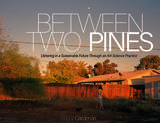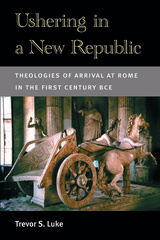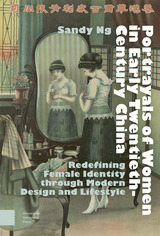2 books about Ushering

Between Two Pines
Ushering in a Sustainable Future Through an Art-Science Practice
Edgar Cardenas
Michigan Publishing Services, 2019
The stories we tell matter. They shape and frame how we identify, understand, and address challenges. Many of the sustainability stories being told and re-told have been predicated on the idea that techno-scientific solutions will be our salvation. Rarely do they deeply interrogate the cultural and aesthetic factors that contribute to our human-environment relationships. Between Two Pines builds on the growing realization that artists must contribute to and enlarge our current conceptions of sustainability. This book explores how conceptions of the sublime, beauty, and the picturesque influenced the development of our natural aesthetic sensibilities and resolves that sustainability stewardship will require the intersection of ecology, aesthetics, and ethics. Pivoting off the history of landscape photography, Cardenas proposes a sustainability aesthetic, a framework for how the arts can reposition themselves for a sustainability social practice. The book concludes with one hundred little dramas, a body of photographic work that puts to practice his sustainability aesthetic. Between Two Pines places scholarship and art on equal footing, ultimately providing a framework and examples of how art practice can and must be integrated into dialogues and narratives on transitioning into a more sustainable future.
“I am truly thankful that Dr. Edgar Cardenas’s thoughtful research is now available in this beautiful book. I have recommended his work to more people, both in my personal and professional spheres of my life, than I can count, and I’m glad to have this provocative and elegant publication to put into people’s hands. Cardenas shows us how each of us really can make a difference.”
“Between Two Pines anticipates and leads the discussion of scholarship around questions of land and landscape. This work brilliantly and ethically refocuses our vision, from distanced scrutiny to connection and proximity, rooted in daily care-taking and ecological efforts. Thoughtfully imaged, the photographs offer an aesthetic that is based in balanced, enduring reflection, rather than on the grand view. These beautiful images reveal discoveries that bridge the arts, ecology, and sociology, and will serve to reconnect every reader with the world in their backyard and beyond.”
“Drawing from a long photographic tradition of examining the relationship between humans and their environment, Edgar Cardenas has found a voice that is as compassionate as it is poignant. Yet he is not content for his photographs to be mere observations, recording the relationship. Between Two Pines is a call to action – a platform by which we might imagine together, with all of the tools in our tool kit, a sustainable future.”
* * *
“I am truly thankful that Dr. Edgar Cardenas’s thoughtful research is now available in this beautiful book. I have recommended his work to more people, both in my personal and professional spheres of my life, than I can count, and I’m glad to have this provocative and elegant publication to put into people’s hands. Cardenas shows us how each of us really can make a difference.”
Rebecca A. Senf, Chief Curator, Center for Creative Photography, University of Arizona, and author of Making a Photographer
“A truly beautiful and thought provoking treatise on the productive relationship between art and science. In Between Two Pines, Cardenas breaks new interdisciplinary ground through an innovative rethinking of sustainability. This book is a call to action that forces the reader to rethink the antiquated and often paralyzing divisions between the arts and the hard sciences.”
Jason De León, Anthropology and Chicana/o Studies, UCLA, MacArthur Fellow, and author of The Land of Open Graves
“Understanding that broad and complex fields of inquiry must be committed to multiple approaches, Edgar Cardenas makes a cogent and well-grounded case for artistic research in the literatures of sustainability. He also offers his own visual essay—punctuated by philosophical reference and personal reflection—on what it means to live fully engaged with the often unnoticed world at our fingertips. Between Two Pines is an insightful offering on how to open the door to artistic practices in research.”
Joey Orr, Andrew W. Mellon Curator for Research, Spencer Museum of Art, University of Kansas
“Between Two Pines anticipates and leads the discussion of scholarship around questions of land and landscape. This work brilliantly and ethically refocuses our vision, from distanced scrutiny to connection and proximity, rooted in daily care-taking and ecological efforts. Thoughtfully imaged, the photographs offer an aesthetic that is based in balanced, enduring reflection, rather than on the grand view. These beautiful images reveal discoveries that bridge the arts, ecology, and sociology, and will serve to reconnect every reader with the world in their backyard and beyond.”
Rebekah Modrak, School of Art & Design, University of Michigan, and author of Reframing Photography
“Drawing from a long photographic tradition of examining the relationship between humans and their environment, Edgar Cardenas has found a voice that is as compassionate as it is poignant. Yet he is not content for his photographs to be mere observations, recording the relationship. Between Two Pines is a call to action – a platform by which we might imagine together, with all of the tools in our tool kit, a sustainable future.”
J.D. Talasek, Director, Cultural Programs of the National Academy of Sciences
"This book is about many things. It is about storytelling, and it tells stories. It is about aesthetics and awareness, and it envelopes us in its distinctive aesthetic and heightens our awareness. It presents science and art as complementary modes of inquiry, and uses art and science to guide us along a path of inquiry. Words and images combine to carry us along an exploration of what sustainability means as a principle in everyday life. "One hundred little dramas" complete the book by immersing the reader--who has now become an observer and inquirer, collaborating with the author--in a world re-enchanted through compassionate observation, free of glamour or pity."
Edward J. Hackett, Vice Provost for Research, Brandeis University
[more]

Ushering in a New Republic
Theologies of Arrival at Rome in the First Century BCE
Trevor S. Luke
University of Michigan Press, 2014
The ancient Romans are well known for their love of the pageantry of power. No single ceremony better attests to this characteristic than the triumph, which celebrated the victory of a Roman commander through a grand ceremonial entrance into the city that ended in rites performed to Rome’s chief tutelary deity, Jupiter Optimus Maximus, on the Capitoline hill. The triumph, however, was only one form of ceremonial arrival at the city, and Jupiter was not the only god to whom vows were made and subsequently fulfilled at the end of a successful assignment. Ushering in a New Republic expands our view beyond a narrow focus on the triumph to look at the creative ways in which the great figures of Rome in the first century BCE (men such as Sulla, Caesar, Augustus, and others) crafted theological performances and narratives both in and around their departures from Rome and then returned to cast themselves in the role of divinely supported saviors of a faltering Republic.
Trevor S. Luke tackles some of the major issues of the history of the Late Republic and the transition to the empire in a novel way. Taking the perspective that Roman elites, even at this late date, took their own religion seriously as a way to communicate meaning to their fellow Romans, the volume reinterprets some of the most famous events of that period in order to highlight what Sulla, Caesar, and figures of similar stature did to make a religious argument or defense for their actions. This exploration will be of interest to scholars of religion, political science, sociology, classics, and ancient history and to the general history enthusiast. While many people are aware of the important battles and major thinkers of this period of Roman history, the story of its theological discourse and competition is unfolded here for the first time.
[more]
READERS
Browse our collection.
PUBLISHERS
See BiblioVault's publisher services.
STUDENT SERVICES
Files for college accessibility offices.
UChicago Accessibility Resources
home | accessibility | search | about | contact us
BiblioVault ® 2001 - 2024
The University of Chicago Press









